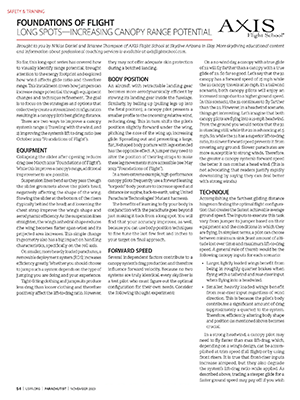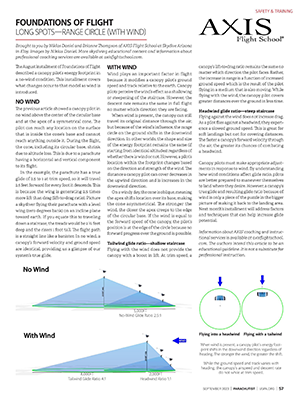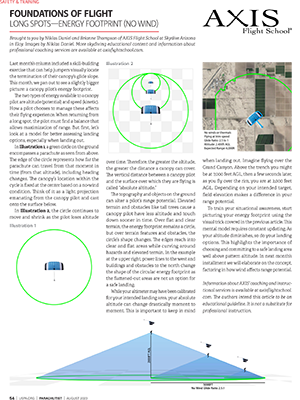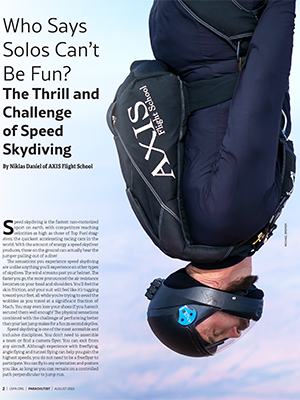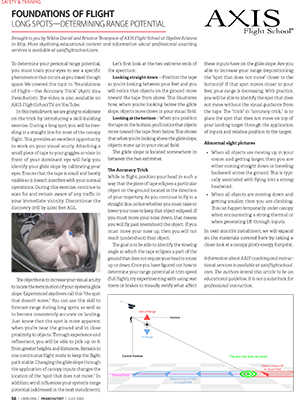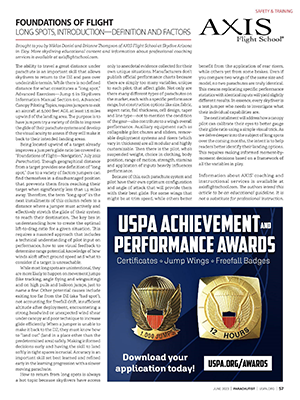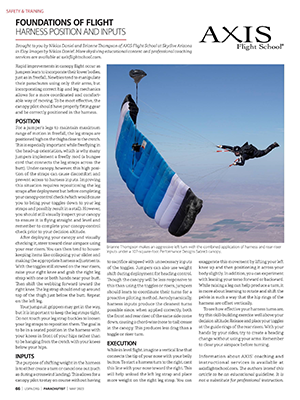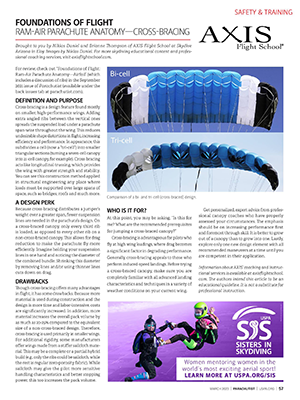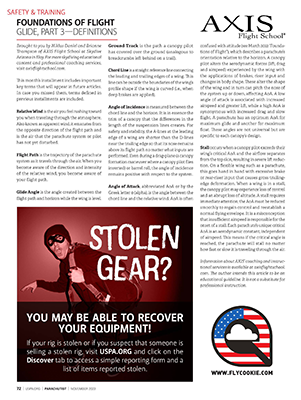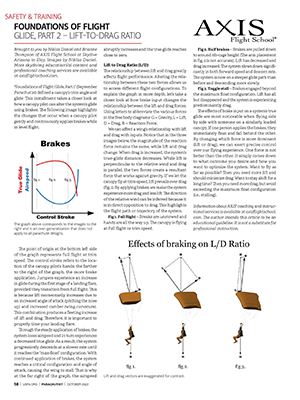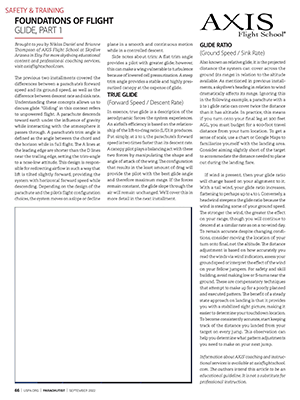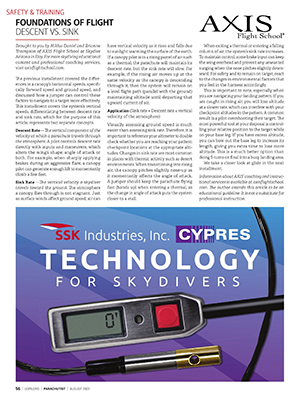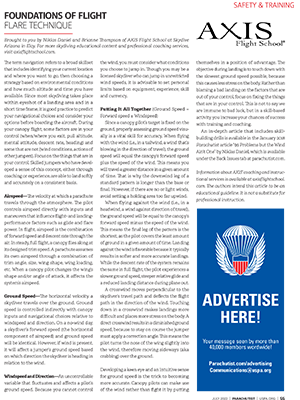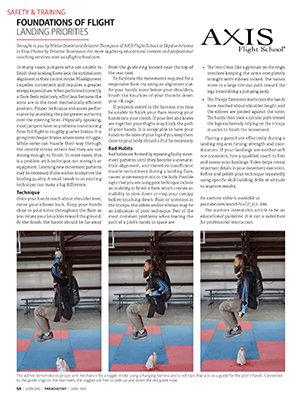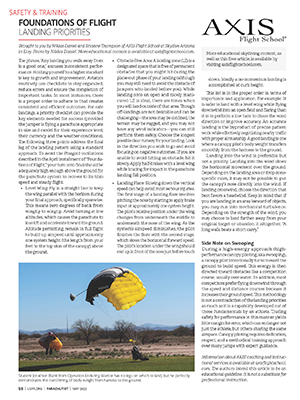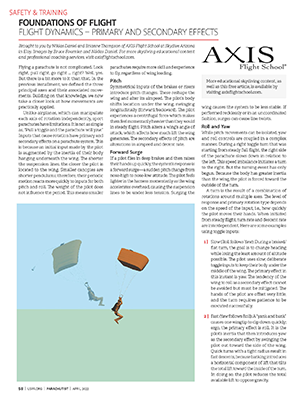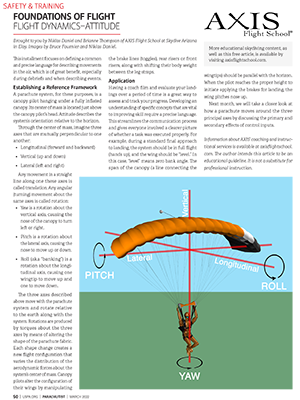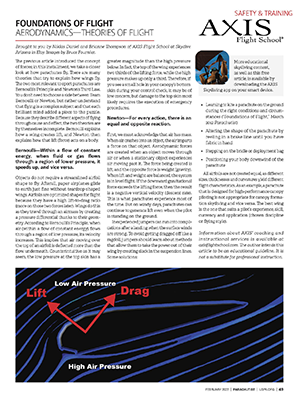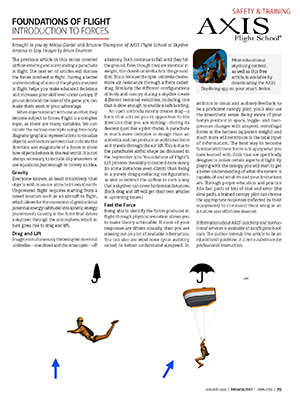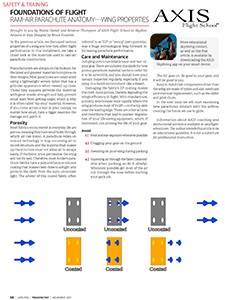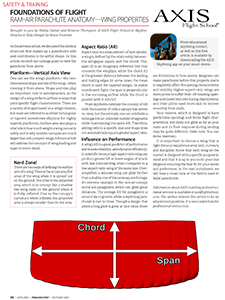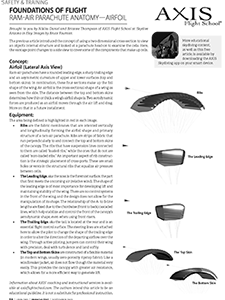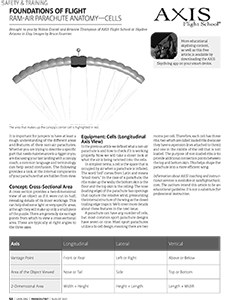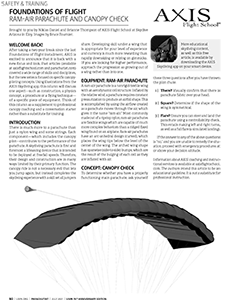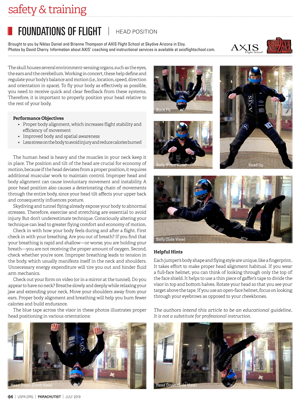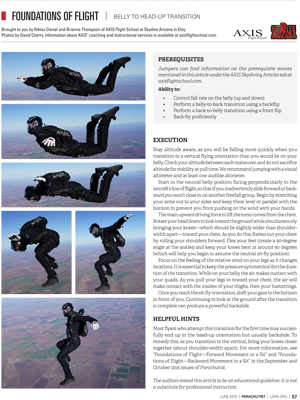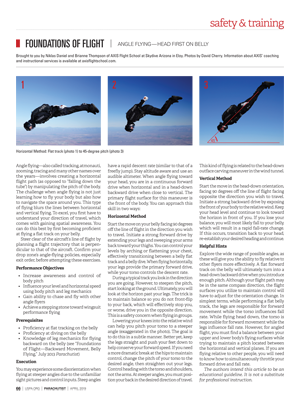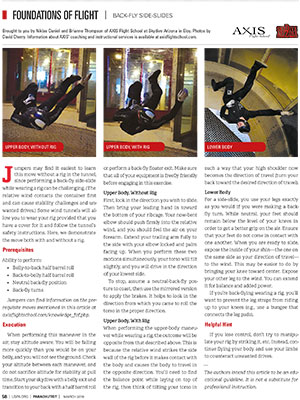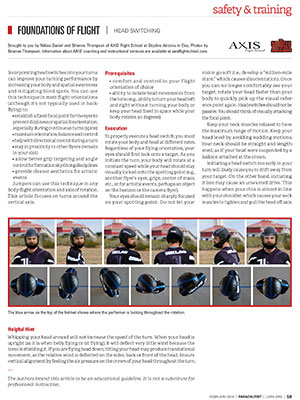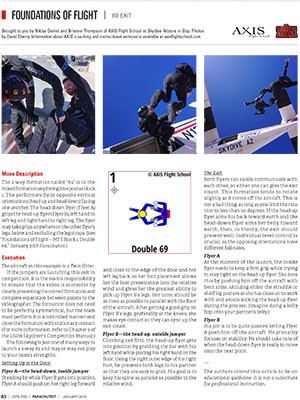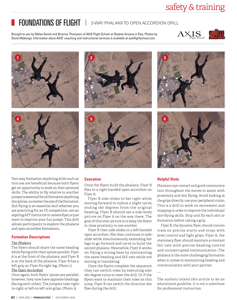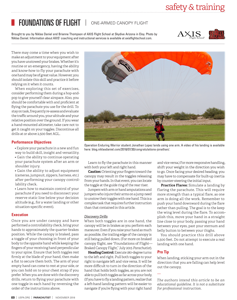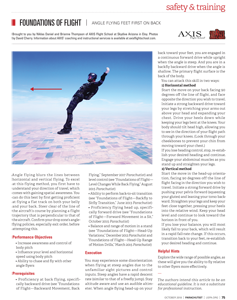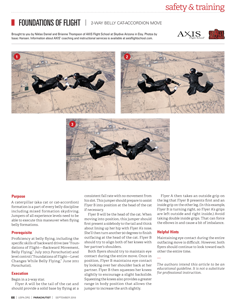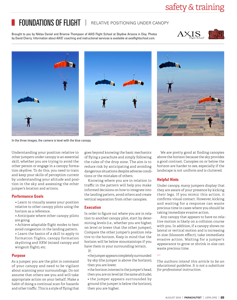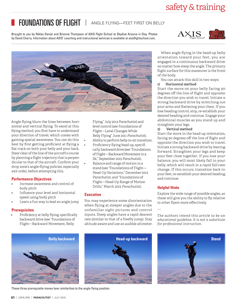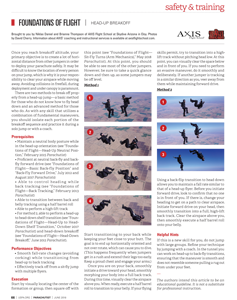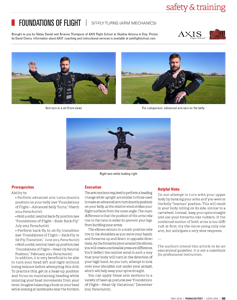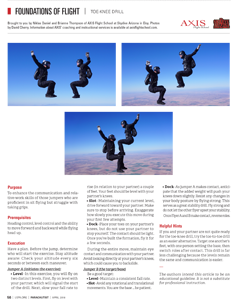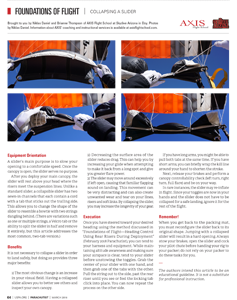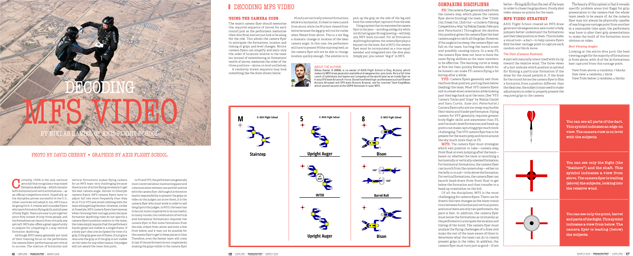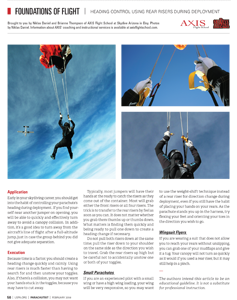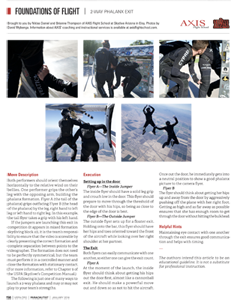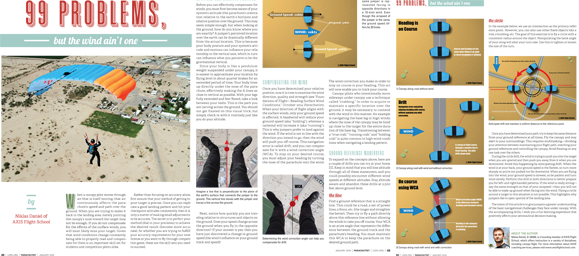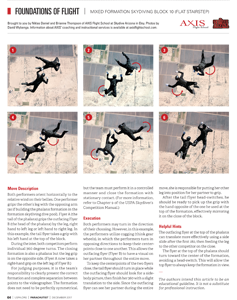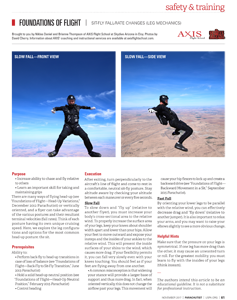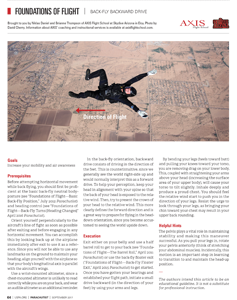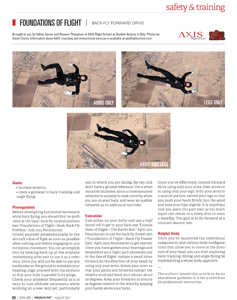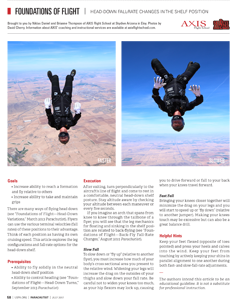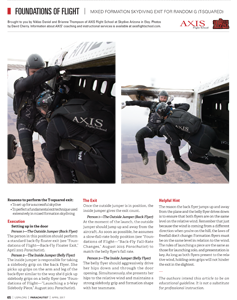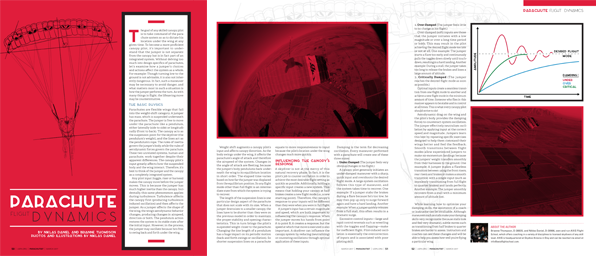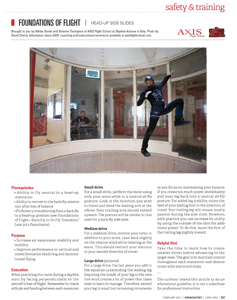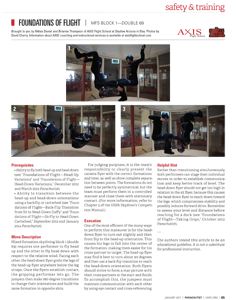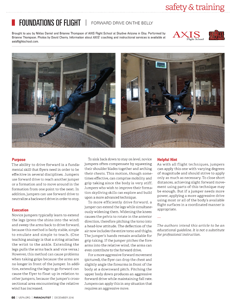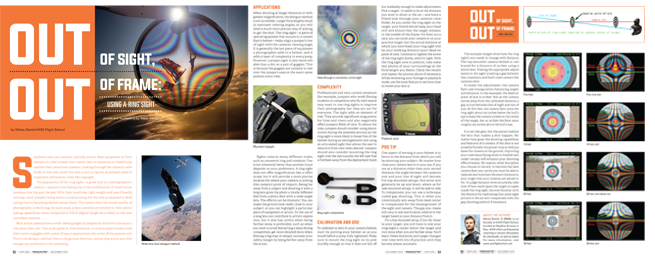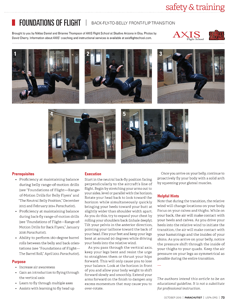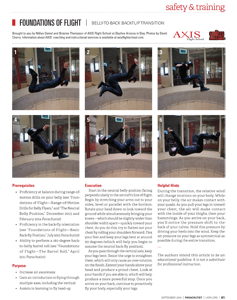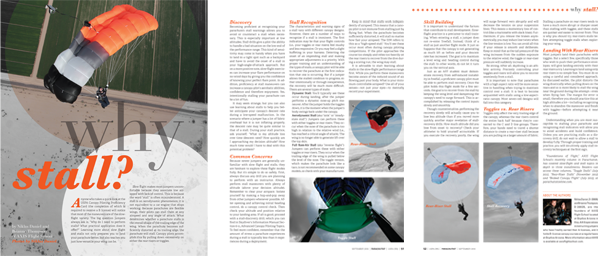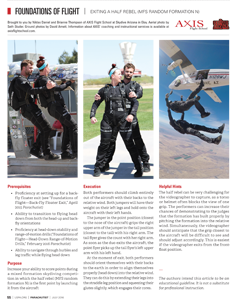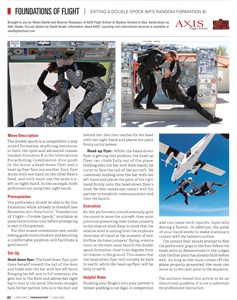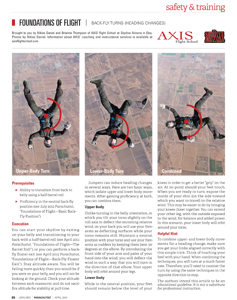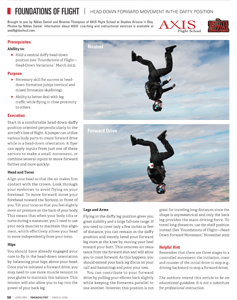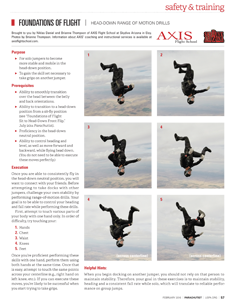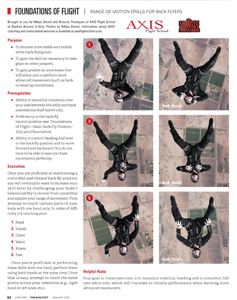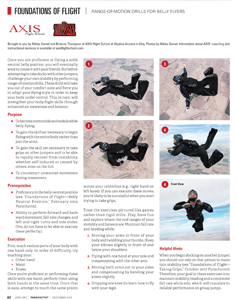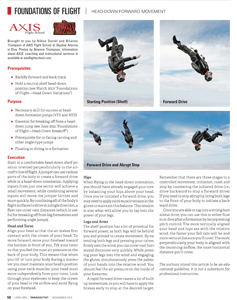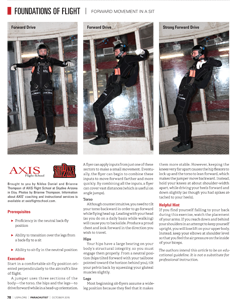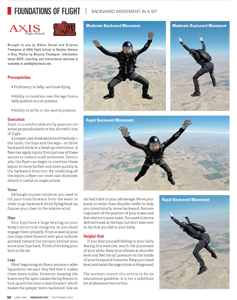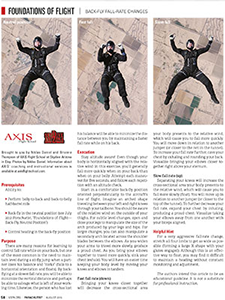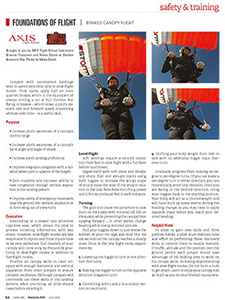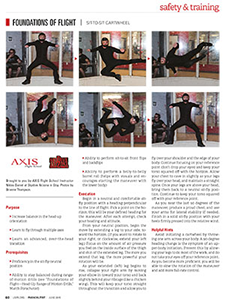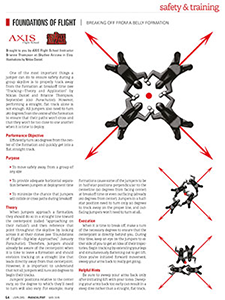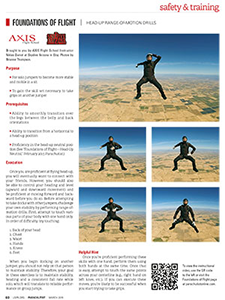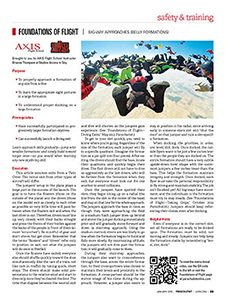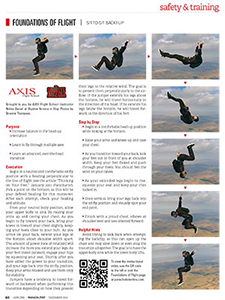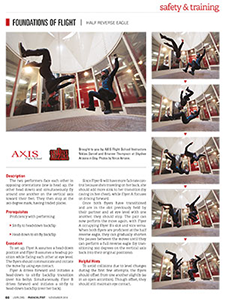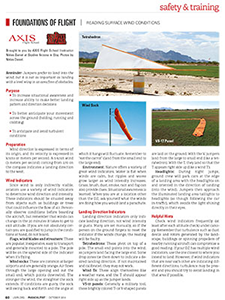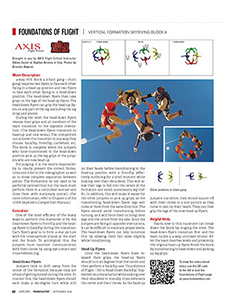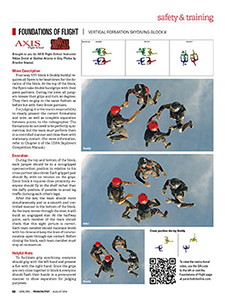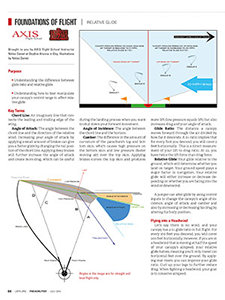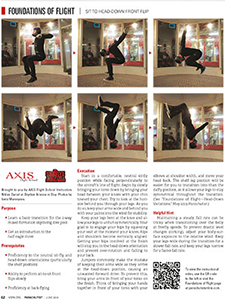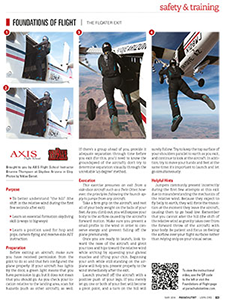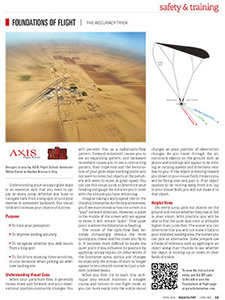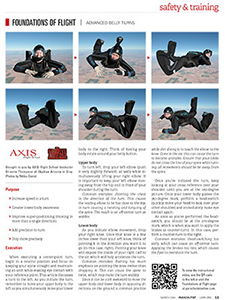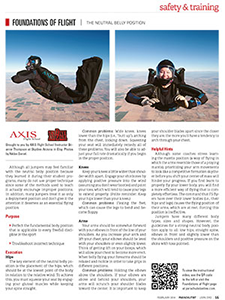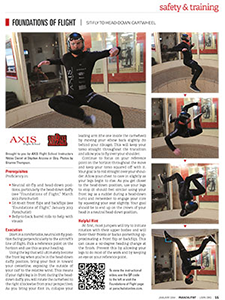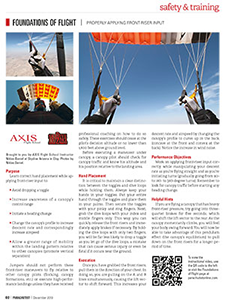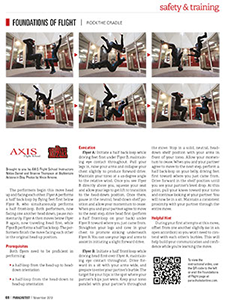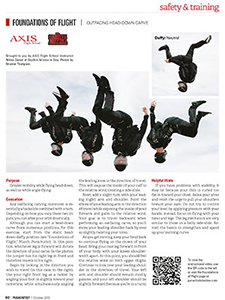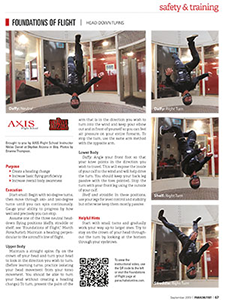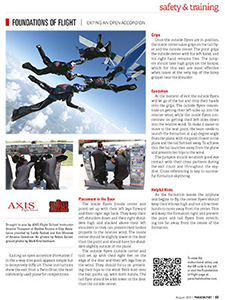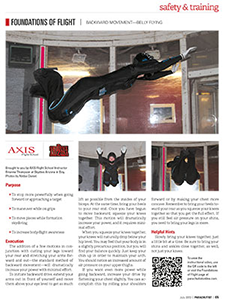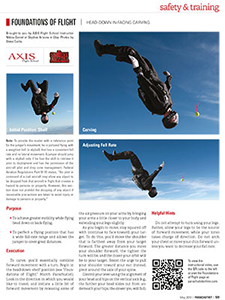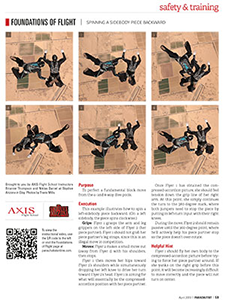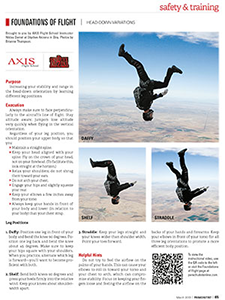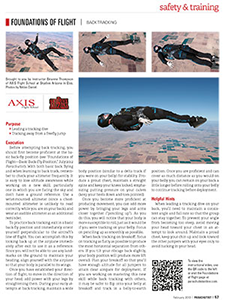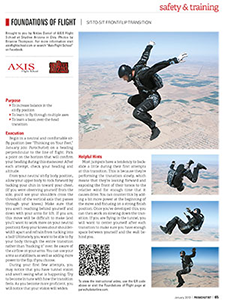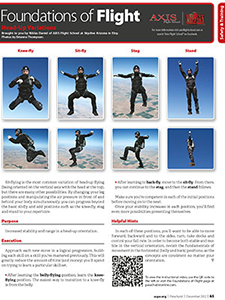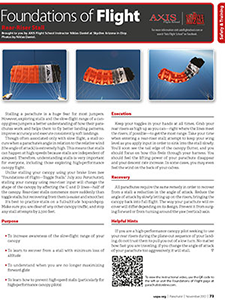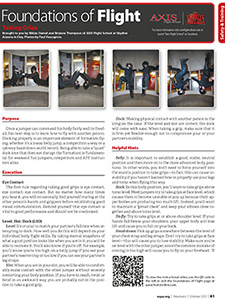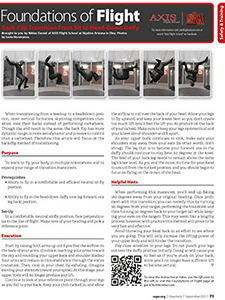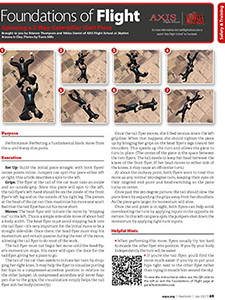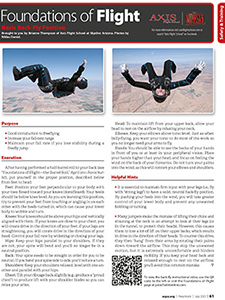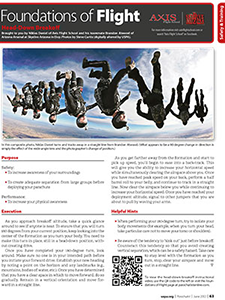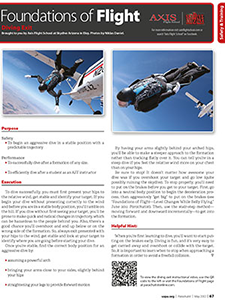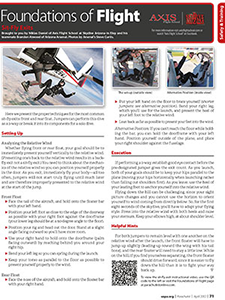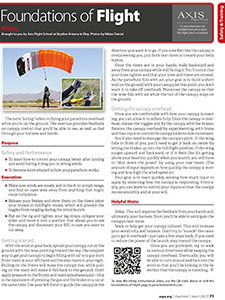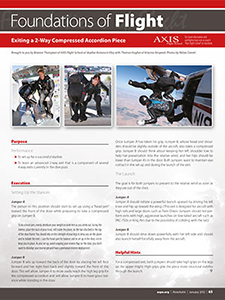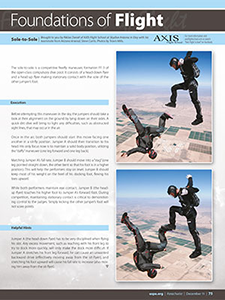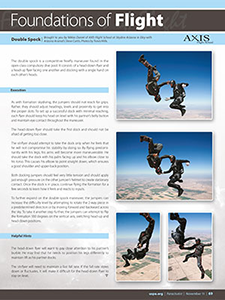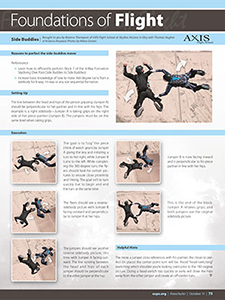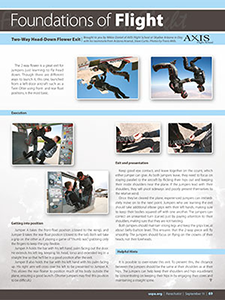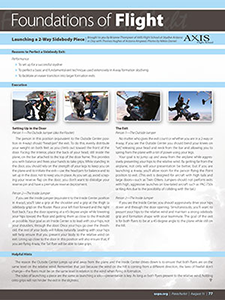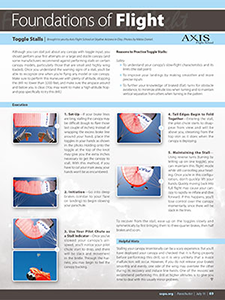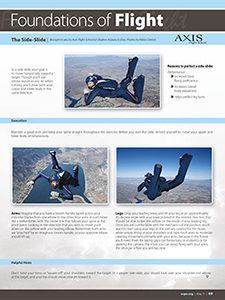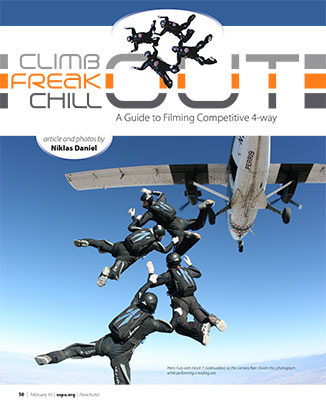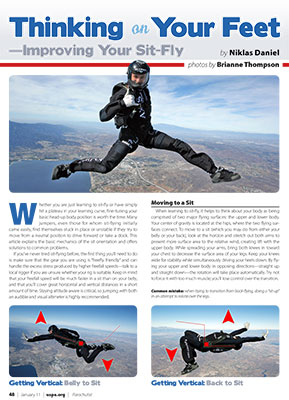Foundations of Flight #125:
Long Spots—Increasing Canopy Range Potential
This installment covers how jumpers can increase range potential through equipment changes and technique refinement. The goal is to focus on strategies and options that collectively create a streamlined configuration resulting in a canopy pilot's best gliding distance.
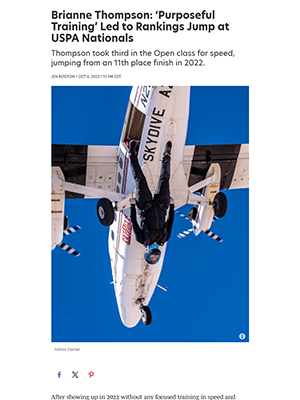
Photo by Niklas Daniel.
Brianne Thompson: 'Purposeful Training' Led to Rankings Jump at USPA Nationals
Thompson took third in the Open class for speed, jumping from an 11th place finish in 2022.
After showing up in 2022 without any focused training in speed and ranking 11th, Brianne Thompson jumped up to the podium this year after spending much of 2023 training in speed with national champion (and husband) Niklas Daniel. Brianne Thompson won third place in the Open class at the 2023 USPA Nationals in September, scoring bronze against the best male and female speed fliers in the with an average speed of 473.76 kilometers per hour.

Where can people hit 300 mph?
In this rural NC spot, with the world's best skydivers.
Article about the USPA National Championships 2023, including speed skydiving, featuring – among others Brianne Thompson and Niklas Daniel.
Foundations of Flight #124:
Long Spots—Range Circle (With Wind)
The previous article showed a canopy pilot in no wind above the center of the circular base and at the apex of a symmetrical cone. This installment covers what changes occur to that model as wind is introduced. Wind plays an important factor in flight because it modifies the canopy pilot's ground speed and track relative to the earth.
Foundations of Flight #123:
Long Spots—Energy Footpring (No Wind)
This month, we pan out to see a slightly bigger picture: a canopy pilot's energy footprint. The two types of energy available to us are altitude (potential) and speed (kinetic). How a pilot chooses to manage these affects their flying experience. When returning from a long spot, the pilot must find a balance that allows maximization of range.
Who Says Solos Can't Be Fun
The Thrill and Challenge of Speed Skydiving
Speed skydiving is the fastest non-motorized sport on earth, with competitors reaching velocities as high as those of Top Fuel dragsters, the quickest accelerating racing cars in the world. With the amount of energy a speed skydiver produces, those on the ground can actually hear the jumper pulling out of a dive! The sensations you experience speed skydiving are unlike anything you'll experience on other types of skydives.
Foundations of Flight #122:
Long Spots—Determining Range Potential
To determine your personal range potential, you must train your eyes to see a specific phenomenon that occurs as you travel through space. In this installment, we are going to elaborate on the trick by introducing a skill-building exercise. We covered this topic in "Foundations of Flight—the Accuracy Trick" (April 2014 Parachutist). The video is also available on AXIS FlightSchoolTV on YouTube.
Foundations of Flight #121:
Long Spots, Introduction—Definition and Factors
The ability to travel a great distance under parachute is an important skill that allows skydivers to return to the DZ and pass over undesirable terrain. While there is no defined distance for what constitutes a "long spot", Advanced Exercises (Jump 5 in Skydivers Information Manual Section 6-11, Advanced Canopy Piloting Topics) requires jumpers to exit an aircraft at 5,000 feet AGL at least 1.5 miles upwind of the landing area.
Foundations of Flight #120:
Harness Position and Inputs
Rapid improvements in canopy flight occur as jumpers learn to incorporate their lower bodies; just as in freefall. Newbies tend to manipulate their parachutes using only their arms, but incorporating correct hip and leg mechanics allow for a more coordinated and comfortable way of moving.
Foundations of Flight #119:
Canopy Turns, Spirals and Spins
A canopy pilot will have better control and may respond with greater confidence in a situation involving a turn, a spiral or a spin (whether these maneuvers a practiced intentionally, experiences accidentally or or brought on by malfunction) if they can distinguish between and have a better understanding of them.
Foundations of Flight #118:
Ram-Air Parachute Anatomy—Cross-Bracing
Cross-bracing is a design feature found mostly on smaller, high-performance wings. Adding extra angled ribs between the vertical ones spreads the suspended load under a parachute span-wise througout the wing. This reduces undesirable shape distortions in flight, increasing efficiency and performance.
Foundations of Flight #117:
Glide, Part 3
This month's installment includes important key terms that will appear in future articles. In case you missed them, terms defined in previous installments are included.
Foundations of Flight #116:
Glide, Part 2
The previous installment defined a canopy's trim angle and glide. This installment takes a closer look how a canopy pilot can alter the system's glide using brakes. In this installment we will cover changes that occur when a canopy pilot gently and continuously applies brakes while in level flight and we will cover the effects of braking on the Lift to Drag Ratio.
Foundations of Flight #115:
Glide, Part 1
The previous two installments covered the differences between a parachute's forward speed and ist ground speed, as well as the difference between descent rate and sink rate. Understanding these concepts allows us to discuss glide. "Gliding" in this context refers to unpowered flight. A parachute descends towards earth under the influence of gravity while interacting with the atmosphere it passes through.
Foundations of Flight #114:
Descent vs. Sink
The previous installment covered the differences in a canopy's horizontal speeds, specifically forward speed and ground speed, and discussed how a jumper can control these factors to navigate to a target more effectively. This installment covers the system's vertical speeds, differentiating between descent rate and sink rate, which for the purpose of this article, represents two separate concepts.
Foundations of Flight #113:
Navigation
The term navigation refers to a broad skillset that includes identifying your current location and where you want to go, then choosing a strategy based on environmental conditions and how much altitude and time you have available. Since most skydiving takes place within eyeshot of a landing area and in a short time frame, it is good practice to predict your navigational choices and consider your options before boarding the aircraft. …
Please ignore title in pdf ("Flaring Technique"; print error).
Foundations of Flight #112:
Flare Technique
In many cases, jumpers who are unable to finish their landing flares lack the optimum arm alignment in their control stroke. Misalignment impedes movement and requires a greater energy expenditure. When performed correctly, a flare feels relatively effortless because the arms are in the most mechanically efficient position. Proper technique enhances performance by providing the pilot greater authority over the steering lines.
Foundations of Flight #111:
Landing Priorities
The phrase, "Any landing you walk away from is a good one", excuses inconsistent performance. Holding yourself to a higher standard is key to growth and improvement. Aviators routinely use checklists to stay organized, reduce errors and ensure the completion of important tasks. For safe landings, a priority checklist can provide the key elements needed for success …
Foundations of Flight #110:
Flight Dynamics—Primary and Secondary Effects
Building on the knowledge of our previous articles, we now take a closer look at how movements are practically applied. Unlike airplanes, which can manipulate each axis of rotation independently, sport parachutes have limitations. It is not as simple as "Pull a toggle and the parachute will yaw". Inputs that cause rotation have primary and secondary effects on a parachute system. Let's take a look at that.
Foundations of Flight #109:
Flight Dynamics—Attitude
This installment focuses on defining a common and precise language for describing movements in the air, which is of great benefit, especially during debriefs and when describing events. This lays the basis for the next installment in this series, which will take a closer look at how a parachute moves around its three principal axes.
Foundations of Flight #108:
Aerodynamics—Theories of Flight
This article focuses on how parachutes fly and look at the two theories most relevant to sport parachutes: Bernouille"s principal, which explains how a wing creates lift, and Newton"s Third Law, which then explains how that lift (force) acts on a body.
Foundations of Flight #107:
Introduction to Forces
The next set of articles will discuss the forces involved in flight. Having a better understanding of some of the physics involved in flight helps you make educated decisions and increases your skill level under canopy. If you understand the rules of the game, you can make them work to your advantage.
Foundations of Flight #106:
Ram-Air Parachute Anatomy—Airflow
In previous articles, we discussed some of the inner workings and properties of a ram-air parachute. In this installment, we will take a closer look at how air flows into and around a ram-air parachute.
Foundations of Flight #105:
Ram-Air Parachute Anatomy—Fabrics
Manufacturers are always on the lookout for the latest and greatest materials to improve on their designs. Most parachutes are constructed using a lightweight woven nylon that has a grid-like appearance when viewed up close. These tiny squares provide the material with great tensile strength and help prevent small tears from getting larger, which is why it is often called "rip-stop" material. …
Foundations of Flight #104:
Ram-Air Parachute Anatomy—Wing Properties
In this article, we shift our vantage point to view the parachute from above: One can see the wing's planform—the two-dimensional shape and size of the wing—when viewing it from above. Shape and size play an important role in aerodynamics, as the design of a wing deflects airflow in ways that yield specific flight characteristics. …
Foundations of Flight #103:
Ram-Air Parachute Anatomy—Airfoil
The previous article introduced the concept of using a two-dimensional cross-section to view an object's internal structure and looked at a parachute head-on to examine the cells. Here, the vantage point changes to a side view to cover some of the components that make up cells. …
Foundations of Flight #102:
Ram-Air Parachute Anatomy—Cells
It is important for jumpers to have at least a rough understanding of the different areas and features of theur ram-air parachutes. Whether you are trying to describe a specific part that needs maintenance by a rigger or you are discussing your las landing with a canopy coach, a common language and terminology can help avoid confusion. …
Foundations of Flight #101:
Ram-Air Parachute and Canopy Check
There is much more to a parachute than just a nylon wing and some strings. Each component—which includes the canopy pilot—contributes to the performance of the parachute. The canopy ride is not a necessary evil that lets you jump again, but instead completes the skydiving experience with a skill set all jumpers share. Developing skills under a wing that is appropriate for your level of experience and currency is much more rewarding than rapidly downsizing or relying on gimmicks.
Foundations of Flight #100:
Head Position
The skull houses several environment-sensing organs, such as the eyes, the ears and the cerebellum. Working in concert, these help define and regulate your body's balance and motion (i.e., location, speed, direction and orientation in space). To fly your body as effectively as possible, you need to receive quick and clear feedback from these systems. Therefore, it is important to properly position your head relative to the rest of your body.
Foundations of Flight #99:
Belly to Head-Up Transition
This article looks at the Belly to Head-up Transition and focusses on the technical execution as well as on how it should feel to the jumper. It also includes helpful hints on how to remedy typical problems that arise when a jumper first tries the maneuver.
Foundations of Flight #98:
Vertical Compressed Exit (MFS Random C)
In the 2-way vertical compressed formation (random formation C in the mixed formation skydiving dive pool), the performers fly in opposing orientations, head-up and headdown.
Foundations of Flight #97:
Angle-Flying—Head First on Belly
Angle flying—also called tracking, atmonauti, zooming, tracing and many other names over the years—involves creating a horizontal flight path (as opposed to “falling down the tube”) by manipulating the pitch of the body. The challenge when angle flying is not just learning how to fly your body but also how to navigate the space around you.
Foundations of Flight #96:
Back-fly Side-Slides
The ability to side slide in the back-fly orientation is a fundamental skill that flyers need in order to be effective in several disciplines. Flyers use lateral movements to reach other flyers, build formations, participate in dynamic disciplines, as well be able to make adjustments to any transition that passes through the back-fly orientation. Before attempting side slides on your back, you should first be proficient at the back-fly neutral position.
Foundations of Flight #95:
Head Switching
Incorporating head switches into your turns can improve your turning performance by increasing your body and spatial awareness and mitigating blind spots. Jumpers can use this technique in any body-flight orientation and axis of rotation.
Foundations of Flight #94:
69 Exit (MFS Block 1)
The 2-way formation called “69” is in the mixed formation skydiving dive pool as block 1. Learn more about this exit, where performers fly in opposite vertical orientations (head up and head down) facing one another.
Foundations of Flight #93:
2-Way Phalanx to Open Accordion Drill
Two-way formation skydiving drills such as this one are beneficial because both flyers get an opportunity to work on their personal skills. The ability to fly relative to another jumper is essential for all formation skydiving disciplines, no matter the size of the formation.
Foundations of Flight #92:
One-armed Canopy Flight
There may come a time when you wish to make an adjustment to your equipment after you have unstowed your brakes. Whether it's routine or an emergency, having the ability and know-how to fly your parachute with one hand may be of great value.
Foundations of Flight #91:
Angle-Flying Feet First on Back
Angle flying blurs the lines between horizontal and vertical flying. To excel at this flying method, you first have to understand your direction of travel, which comes with gaining spatial awareness.
Foundations of Flight #90:
2-Way Belly Cat-Accordion Move
A caterpillar (aka cat or cat-accordion) formation is a part of every belly discipline including mixed formation skydiving. Jumpers of all experience levels need to be able to execute this maneuver when flying belly formations.
Foundations of Flight #89:
Relative Positioning Under Canopy
Understanding your position relative to other jumpers under canopy is an essential skill, whether you are trying to avoid the other person or engage in a canopy formation skydive. To do this, you need to train and keep your skills of perception current.
Foundations of Flight #88:
Angle-Flying—Feet First on Belly
Angle flying blurs the lines between horizontal and vertical flying. To excel at this flying method, you first have to understand your direction of travel, which comes with gaining spatial awareness. You can do this best by first getting proficient at flying a flat track on both your belly and your back.
Foundations of Flight #87:
Head-Up Breakoff
Once you reach breakoff altitude, your primary objective is to create a lot of horizontal distance from other jumpers in order to deploy your parachute safely. It may be difficult to know the location of every person on your jump, which is why it is your responsibility to clear your airspace while moving away. Avoiding collisions in freefall, during deployment and under canopy is paramount.
Foundations of Flight #86:
Sit-Fly Turns (Arm Mechanics)
This ability will help you to perform advanced arm turns (mantis position) on your belly, hold a solid, neutral back-fly position, perform back-fly to sit-fly transition, hold a solid, neutral head-up position, etc.
Foundations of Flight #85:
Toe-Knee Drill
The purpose of this drill is to enhance the communication and rela-tive-work skills of those jumpers who are proficient in sit flying but struggle with taking grips.
Removable Deployment Systems
Fashion or Function?
Where previously only highly experienced canopy pilots have used a RDS, now more skydivers with less experience are jumping them. Are they using this piece of gear as a fashion statement or status symbol, or are they using it for its function?
Foundations of Flight #84:
Collapsing a Slider
Unlike a standard slider, a collapsible slider has two sewn-in channels that each contain a cord with a tab that sticks out the trailing side. This allows you to change the shape of the slider to resemble a bowtie with two strings dangling behind. Learn about the benefits and the execution of collapsing a slider.
Decoding MFS Video
Although MFS teams generally put most of their training focus on the performers, the camera flyers' performances are critical to success. The mixture of horizontal and vertical formations makes flying camera for an MFS team very challenging because there is a lot of active flying necessary to get the best camera angle.
Foundations of Flight #83:
Heading Control Using Rear Risers During Deployment
If you find your-self near another jumper on opening, you will be able to quickly and effectively turn away to avoid a canopy collision. In addition, it's a good idea to turn away from the aircraft's line of flight after a full-altitude jump, just in case the group behind you did not give adequate separation.
Foundations of Flight #82:
2-Way Phalanx Exit
Learn all about the 2-Way Phalanx exit, from move desciption to execution and helpful hints.
99 Problems, but the Wind ain't One
When a canopy pilot moves through air that is itself moving, that air continuously affects the parachute's speed and path over the ground. When you are trying to make it back to the landing area, merely pointing the canopy's nose toward the target may not be enough.
99 Problems, but the Wind ain't One (French and English)
See above. The content is available in French and English.
Foundations of Flight #81:
MFS Block 10 (Flat Stairstep)
Learn all about the Mixed Formation Skydiving Block 10 (Flat Stairstep), from move desciption to execution and helpful hints.
Cloud Clearance
Practical Tips
Most jumpers have a difficult time remembering the cloud clearance regulations [FAR 105.17]. Understanding the reasons for the different altitude requirements can help you remember the necessary information.
Foundations of Flight #80:
Sit-Fly Fall-Rate Changes (Leg Mechanics)
Increase your ability to chase and fly relative to others and learn an important skill for taking and maintaining grips! There are many ways of flying head-up or vertically oriented, and a flyer can take advantage of the various postures and their resultant terminal velocities (fall rates).
Foundations of Flight #79:
Head-Up to Head-Down Shelf Transition
The goals of this drill are to increase your mobility and to help you gain the ability to transition from one flight mode to another mid-jump. Learn a skill used extensively in vertical and mixed formation skydiving.
Foundations of Flight #78:
Back-Fly Backward Drive
The goals of this drill are to increase your mobility and build air awareness.
Foundations of Flight #77:
Back-Fly Forward Drive
The goals of this drill are to increase your mobility and open a gateway to back tracking and angle flying.
Foundations of Flight #76:
Head-Down Fall-Rate Changes in the Shelf Position
Increase your ability to reach a formation and fly relative to others. Increase your ability to take and maintain grips. There are many ways of flying head down. Flyers can use the various terminal velocities (fall rates) of these positions to their advantage.
Foundations of Flight #75:
MFS Random F (Totem)
Learn all about the Mixed Formation Skydiving Random F (Totem), from move desciption to execution and helpful hints.
Foundations of Flight #74:
MFS Block 8 (Bison)
Learn all about the Mixed Formation Skydiving Block 8 (Bison), from move desciption to execution and helpful hints.
Foundations of Flight #73:
MFS Exit for Random G (T-Squared)
Learn all about the Mixed Formation Skydiving Random G (T-Squared), from move desciption to execution and helpful hints.
Foundations of Flight #72:
2-Way Belly Star Exit
Increase your air awareness, stability and mobility, and improve your performance in vertical and mixed formation skydiving and dynamic tunnel flying.
Parachute Flight Dynamics
To become a more proficient canopy pilot, it's important to understand that the jumper is not separate from the canopy but is in fact part of an integrated system. Without delving too much into design specifics of parachutes, let's examine how a jumper's choices and actions affect the system as a whole.
Foundations of Flight #71:
Head-Up Side Slides
Increase your air awareness, stability and mobility, and improve your performance in vertical and mixed formation skydiving and dynamic tunnel flying.
Foundations of Flight #70:
MFS Block 1—Double 69
Learn all about the Mixed Formation Skydiving Block 1 (Double 69), from move desciption to execution and helpful hints.
Foundations of Flight #69:
Forward Drive on the Belly
The ability to drive forward is a fundamental skill that flyers need in order to be effective in several disciplines. Jumpers use forward drive to reach another jumper or a formation, to move around in the formation from one point to the next, and to neutralize a backward drive in order to stop.
Out of Sight, Out of Frame
Using a Ring Sight
Skydivers who use cameras typically mount their equipment to their helmets in order to keep their hands clear to maneuver in freefall and operate their parachute systems. Looking through the camera's viewfinder to aim and center the shot is not an option. Enter the ring sight.
Foundations of Flight #68:
2-Way MFS Block 7—Periscope-Periscope
Learn all about the Mixed Formation Skydiving Block 7 (Periscope), from move desciption to execution and helpful hints.
Foundations of Flight #67:
Back-Fly-to-Belly Front-Flip Transition
Increase air awareness, gain an introduction to flying through the vertical axis, and learn to fly through multiple axes. This skill also assists with learning to fly head up.
Foundations of Flight #66:
Belly-to-Back Backflip Transition
Increase air awareness, and gain an introduction to flying through multiple axes, including the vertical. This skill also assists in learning to fly head-up.
Why Stall?
Anyone who takes a quick look at the USPA Canopy Piloting Proficiency Card will notice that most of the maneuvers are of the slowflight variety. The big question is, "Why do I need to perform stalls? What practical application does it offer?" Learning more about slow flight and stalls not only prepares you to land your parachute better, but also teaches you just how versatile your wing can be.
Foundations of Flight #65:
Head-Down Side-Slides
Increase air awareness, stability and mobility. Improve your vertical and mixed formation skydiving skills.
Foundations of Flight #64:
Exiting a Half Rebel (MFS Random N)
Increase your ability to score points during a mixed formation skydiving competition in which the half rebel (MFS random formation N) is the first point by launching it from the aircraft.
Foundations of Flight #63:
Exiting a Double Spock (MFS Random B)
Learn all about exiting a Mixed Formation Skydiving Random B (Double Spocl), from move desciption, prerequisites, set-up, to execution and helpful hints.
Foundations of Flight #62:
Climbing to a Camera Step
Formation skydiving camera flyers make the most use of camera steps, but jumpers in other disciplines will also find them useful at times. Camera steps and their accompanying handles come in a variety of shapes and sizes. However, due to the plane size, safety concerns or structural issues, they cannot be found at all drop zones.
Foundations of Flight #61:
Back-Fly Turns (Heading Changes)
Jumpers can induce heading changes in several ways. This article covers two basic ways, which isolate upper and lower body move-ments. After gaining proficiency at both, you can combine them.
Foundations of Flight #60:
Head-Down Foreward Movement in the Daffy Position
This is a necessary skill for success at head-down formation jumps (vertical and mixed formation skydiving) which can help you gain the ability to better deal with leg traffic while flying in close proximity to others.
Foundations of Flight #59:
Head-Down Range of Motion Drills
The purpose of these drills is for solo jumpers to become more stable and mobile in the head-down position and to gain the skill set necessary to take grips on another jumper.
Foundations of Flight #58:
Range of Motion Drills for Back-Flyers
The purpose of these drills is to become more stable and mobile while back-flying solo, to gain the skill set necessary to take grips on other jumpers, and to gain greater air awareness that will allow you to perform more advanced maneuvers (such as back- to-head-up transitions).
Foundations of Flight #57:
Range of Motion Drills for Belly-Flyers
The purpose of these drills is to become more stable and mobile while belly flying, to gain the skill set necessary to begin flying with the entire body, to gain the skill set necessary to take grips on other jumpers, to rapidly recover from instability (self induced, caused by others, even on the hill), to counteract unwanted movement during maneuvers.
Foundations of Flight #56:
Head-Down Forward Movement
This is a necessary skill for succeeding at head-down formation jumps (VFS and MFS). It is also essential for breaking off from a head-down jump and a prerequisite for in-facing carving and other angle-type jumps as well as floating or diving to a formation.
Foundations of Flight #55:
Forward Movement in a Sit
A jumper uses three sections of the body – the torso, the hips and the legs – to drive forward while in a head-up orientation. A flyer can apply inputs from just one of these sectors to make a small movement. Eventually, the flyer can begin to combine these inputs to move forward farther and more quickly.
Foundations of Flight #54:
Backward Movement in a Sit
A jumper uses three sections of the body – the torso, the hips and the legs – to drive backward while in a head-up orientation. A flyer can apply inputs from just one of these sectors to make a small movement. Eventu-ally, the flyer can begin to combine these inputs to move farther and more quickly in the backward direction.
Foundations of Flight #53:
Back-Fly Fall-Rate Changes
There are many reasons for learning to control fall rate while on your back, but one of the most common is the need to maintain level during a sit-fly jump when a partner loses his balance and “corks”. By back-flying at a slower fall rate, you will be able to minimize the vertical distance and perhaps be able to salvage what is left of your working time.
Foundations of Flight #52:
Braked Canopy Flight
The purpose of this drill is to increase a pilot's awareness of a canopy's control range, awareness of a canopy's bank angle and angle of attack, landing proficiency, and long-spot navigation with a tail-wind. It also helps to gain mobility and increase the ability to ease congestion in the landing pattern as well as improve safety of emergency maneuvers near the ground.
Foundations of Flight #51:
Sit-to-sit Cartwheel
The purpose of this drill is to increase balance in the head-up orientation, to learn to fly through multiple axes, and to learn an advanced, over-the-head transition.
Foundations of Flight #50:
Breaking off from a Belly Formation
One of the most important things a jumper can do to ensure safety during a group skydive is to properly track away from the formation at breakoff time. However, performing a straight, flat track alone is not enough.
Land unter
(Water Landings Training - German Edition)
Die Bezeichnung Sky Diving bekommt eine dramatisch andere Bedeutung, wenn ein Springer bei der Landung – statt festen Boden zu spüren – weit mehr als nur nasse Füße bekommt. Damit es in einer solchen Ausnahmesituation nicht „drunter und drüber“ geht, sondern rein und zügig wieder raus, empfiehlt sich eine entsprechende Vorbereitung.
Foundations of Flight #49:
Back-Fly Floater Exit
Get a better understanding of “the hill” (the directional shift in the relative wind immediately after exit) and and introduction to freefly exits.
Foundations of Flight #48:
Head-Up Range-of-Motion Drills
This installment is for solo jumpers looking to become more stable and mobile in a sit and to gain the skill set necessary to take grips on another jumper.
Training for Water Landings
More Than Just a Sign-Off
Training for intentional and unintentional water landings is an important part of a skydiver's learning progression and is required to receive the USPA B license. Unfortunately, most jumpers rarely give it much thought after their instructors sign them off for this skill, and few take the time to carefully consider the dangers involved.
Foundations of Flight #47:
Head-Up Neutral Position
Your fall rate increases when flying in a vertical orientation, and this will reduce your available working time, so give yourself extra time to slow down before your planned deployment altitude. Make sure you have provided adequate exit separation from other jumpers based on the aircraft's ground speed, and be sure to face perpendicularly to the line of flight while in freefall.
Foundations of Flight #46:
Big-Way Approaches (Belly Formations)
Learn how to properly approach a formation of any size from a dive and the appropriate sight pictures in a large formation. Understand proper docking on a large formation.
Foundations of Flight #45:
Sit-to-Sit Backflip
Increase your balance in head-up orientation. Learn to fly through multiple axes and an advanced, over-the-head transition.
Foundations of Flight #44:
Half Reverse Eagle
The two performers face each other in opposing orientations (one is head up, the other head down) and simultaneously fly around one another on the vertical axis toward their feet. They then stop at the 180-degree mark, having traded places.
Foundations of Flight #43:
Reading Surface Wind Conditions
Increase situational awareness and increase ability to make better landing pattern and direction decisions. Better anticipate your movement across the ground (holding, running and crabbing). Anticipate and avoid turbulent conditions.
Foundations of Flight #42:
VFS Block 4
Learn all about the Vertical Formation Skydiving Block 4 (Chain Gang), from move desciption to execution (head-down and head-up flyers), and helpful hints.
Foundations of Flight #41:
VFS Block 8
Learn all about the Vertical Formation Skydiving Block 8 (Buddy), from move desciption to execution, and helpful hints.
Foundations of Flight #40:
Relative Glide
Understanding the difference between glide ratio and relative glide as well as how to best manipulate your canopy's control range to affect relative glide.
Foundations of Flight #39:
Sit to Head-Down Front Flip
Learn a basic transition for the 2-way mixed formation skydiving dive pool and get an introduction to the half-eagle move.
Foundations of Flight #38:
The Floater Exit
Better understand “the hill” (the shift in the relative wind during the first few seconds after exit). Learn an essential formation skydiving skill (2-ways to big-ways) and a position used for hop and pops, camera flying and reserve-side AFF instruction.
Foundations of Flight #37:
The Accuracy Trick
Understanding your canopy's glide slope is an essential skill that you need to apply on every jump. Whether you have to navigate back from a long spot or land your reserve in someone's backyard, this visual trick will increase your chance of success.
Foundations of Flight #36:
Advanced Belly Turns
Increase speed in a turn. Gain a greater lower-body awareness. Improve super-positioning (moving in more than a single direction). Learn how to add precision to a turn and how to stop more precisely.
Foundations of Flight #35:
The Neutral Belly Position
Although all jumpers may feel familiar with the neutral belly position, many do not use proper technique since some of the methods used to teach it actually encourage improper positions. Many jumpers mistake it as only a deployment position and miss, that it is also an essential flying position.
Foundations of Flight #34:
Sit-Fly to Head-Down Cartwheel
Before you attempt this maneuver, you need to be proficient in neutral sit-fly and head-down positions, particularly the head-down daffy, with sit-to-sit front flips and backflips, as well as belly-to-back barrel rolls to help with visuals.
Foundations of Flight #33:
Properly Applying Front-Riser Input
Learn correct hand placement while applying front-riser input to: avoid dropping a toggle, increase awareness of a canopy's control range, initiate a heading change, change the canopy's profile to increase descent rate and correspondingly increase airspeed, and allow a greater range of mobility within the landing pattern relative to other canopies.
Foundations of Flight #32:
Rock the Cradle
Before you attempt this maneuver, you need to be proficient in performing a half-loop from the head-up to head-down orientation and a half-loop from the head-down to the head-up orientation.
Foundations of Flight #31:
Outfacing Head-Down Carve
Learn to have greater mobility while flying head-down, as well as while angle-flying.
Foundations of Flight #30:
Head-Down Turns
The purpose of head-down turns is to create a heading change, increase your basic flying proficiencyand your overall body awareness.
Foundations of Flight #29:
Exiting an Open Accordion (4-Way FS Random F)
Exiting an open accordion (formation F in the 4-way dive pool) appears simple but is deceptively difficult. These instructions show the exit from a Twin Otter, the most commonly used plane for competitions.
Foundations of Flight #28:
Backward Movement—Belly Flying
Stop more powerfully when going forward or approaching a target, learn to maneuver while on grips, to move pieces while formation skydiving, and to increase your body-flight awareness.
Foundations of Flight #27:
Back-Fly to Sit-Fly Transition
Learn how to fly through multiple axes and how to recover from sit-fly instability.
Foundations of Flight #26:
Head-Down In-Facing Carving
Achieve greater mobility while flying head-down or while back-flying, and perfect a flying position that has a wide fall-rate range and allows the jumper to cover great distances.
Foundations of Flight #25:
Spinning a Sidebody Piece Backward
Perfect a fundamental block move from the 4- and 8-way dive pools.
Foundations of Flight #24:
Head-Down Variations
Increase your stability and range in the head-down orientation by learning different leg positions.
Foundations of Flight #23:
Back Tracking
Learn how to lead a tracking dive and how to track away from a freefly jump.
Kiting
The term "Kiting" refers to flying your parachute overhead while you're on the ground. The exercise provides feedback that you'llbe able to see, as well as feel through your harness and hands.
Foundations of Flight #22:
Sit-to-Sit Front-Flip Transition
Increase your balance in the sit-fly position, learn to fly through multiple axes, and learn a basic, over-the-head transition.
Foundations of Flight #21:
Head-Up Variations
Sit-flying is the most common variation of head-up flying, but there are many other possibilities. By changing your leg positions and manipulating the air pressure in front of and behind your body simultaneously, you can progress beyond the basic sit-fly and add positions such as the knee-fly, stag and stand to your repertoire.
Foundations of Flight #20:
Rear-Riser Stall
Stalling a parachute is a huge fear for most jumpers. However, exploring stalls and the slow-flight range of a canopy gives jumpers a better understanding of how their parachutes work and helps them to fly better landing patterns, improve accuracy and execute consistently soft landings.
Foundations of Flight #19:
Taking Grips
Docking properly is an important element of formation flying, whether it's a 2-way belly jump, a competition 4-way or a 138-way head-down world record. Being able to take a “quiet” dock (one that does not disrupt the formation) is fundamental for weekend fun jumpers, competitors and AFF instructors alike.
Foundations of Flight #18:
Back-Flip Transition from Sit to Head-Down Daffy
When transitioning from a head-up to a head-down position, most vertical formation skydiving competitors transition over their backs instead of performing cartwheels. Though the end result is the same, the back flip has more dynamic range, is more aerodynamic and is easier to control than a cartwheel.
Foundations of Flight #17:
Spinning a 2-Way-Caterpillar (Cat) Piece
Perfect a fundamental block move from the 4- and 8-way dive pools.
Foundations of Flight #16:
Basic Back-Fly Position
This introduction to freeflying wants to increase your fall-rate range and help you maintain your fall rate if you lose stability during a freefly jump.
Foundations of Flight #15:
Head-Down Breakoff
Safety: increase awareness of your surroundings and create adequate separation from large groups before deploying your parachute. Performance: increase your physical awareness.
Foundations of Flight #14:
Diving Exit
Safety: begin an aggressive dive in a stable position with a predictable trajectory. Performance: successfully dive after a formation of any size or efficiently dive after a student as an AFF instructor.
Foundations of Flight #13:
Sit-Fly Exits
Learn the proper techniques for the most common sit-fly exits: front and rear float. Jumpers can perform this dive as a 2-way or break it into its components for a solo dive.
Foundations of Flight #12:
Kiting
Learn how to control your canopy better after landing and avoid having it drag you in strong winds and become more attuned to how your parachute works.
Foundations of Flight #11:
Two-Way Verticals (aka "Over Unders" or "Burble Hopping")
Safety: Recognize and either avoid or navigate through a burble, avoid getting “taken out” if another jumper goes low on a formation, and avoid having a burble affect stability during a skydive. Performance: Learn a fundamental skill for performing 4-way and 8-way formation skydiving blocks and further develop your fall-rate skills and apply them to a new task.
Foundations of Flight #10:
Exiting a 2-Way Compressed Accordion / Periscope (MFS Block 7)
Set up for a successful skydive and learn an advanced 2-way exit that is a component of several 4-way exits currently in the dive pool.
Foundations of Flight #9:
Sole to sole (MFS Random D)
The sole-to-sole is a competitive freefly maneuver, formation FF-3 of the open-class compulsory dive pool. It consists of a head-down flyer and a head-up flyer making stationary contact with the sole of the other jumper's foot.
Foundations of Flight #8:
Double Spock (MFS Random B)
The double spock is a competitive freefly maneuver found in the open-class compulsory dive pool. It consists of a head-down flyer and a head-up flyer facing one another and docking with a single hand on each other's heads.
Foundations of Flight #7:
Side Buddies (FS Block 7)
Learn how to effciently perform Block 7 of the 4-Way Formation Skydiving Dive Pool (Side Buddies) and increase your basic knowledge of how to make 360-degree turns from a sidebody for 8-way, 16-way or any size sequential formation.
Foundations of Flight #6:
Two-Way Head-Down Flower Exit
The 2-way flower is a great exit for jumpers just learning to fly head down. Though there are different ways to launch it, this one, launched from a left-door aircraft such as a Twin Otter using front- and rear-float positions, is the most basic.
Foundations of Flight #5:
Launching a 2-Way Sidebody Piece
Set up for a successful skydive, perfect a basic and fundamental exit technique used extensively in 4-way formation skydiving, and facilitate an easier transition into larger formation exits.
Foundations of Flight #4:
Toggle Stalls
Reasons to practice toggle Stalls are to understand your canopy's slow-flight characteristics and its limits (the stall point), to improve your landings by making smoother and more precise inputs, to further your knowledge of braked (flat) turns for obstacle avoidance, and to minimize altitude loss when turning and to maintain vertical separation from others when turning in the pattern.
Foundations of Flight #3:
Level Changes While Belly Flying
Safety: avoid collision, understandi and navigate through burbles, stay with students (for rating holders). Performance: get to different vantage points (for camera flyers), make a powerful stop after diving to a base, increase your ability to fly with a wide range of people with a variety of fall rates, and improve your track with slow-flight skills.
Foundations of Flight #2:
The Side Slide
In a side-slide, your goal is to move horizontally toward a target. Though you'll use similar inputs as you do when turning, you'll drive both your upper and lower body in the same direction.
Foundations of Flight #1:
The Barrel Roll
Performance: this maneuver is frequently used transition for back-to-belly freefly compulsory moves in competition. Safety: It is also a technique to recover from instability, used to clear airspace above you prior to deployment and its half-way point, backflying, is a bail-out procedure for free flying (to prevent corking).
XRW
Mixed Formation Flights
A wing-suit flying relative to a canopy is not a new concept; however in the past it has always been considered a stunt rather than a potential discipline. As wing-suit and canopy technology continues to rapidly improve, we can almost guarantee that mixed formation flights will become more commonplace in the future. Therefore it is imperative that we take a closer look at what makes this activity possible and address some of the potential dangers associated with it. This form of flight is very new and safety is of great concern. By no means are we experts on the subject, but we would like to share some of the information we have accumulated over the last year during our training camps.
A Guide to Filming FS 4-Way
Climb Out, Freak Out, Chill Out
This article is for jumpers who already have some experience flying camera and are trying to expand their knowledge of how to film formation teams in a competition setting. I will focus mainly on 4-way, because I believe it to be the most difficult formation skydiving discipline to film (aside from vertical formation skydiving), due to the many different exits and faster key speeds. However, once you have a firm grasp of shooting 4-way, the same principles can be applied to 8-way and larger formations.
Thinking on Your Feet
Improving Your Sit-Fly
Whether you are just learning to sit-fly or have simply hit a plateau in your learning curve, fine-tuning your basic head-up body position is worth the time. Many jumpers, even those for whom sit-flying initially came easily, find themselves stuck in place or unstable if they try to move from a neutral position to drive forward or take a dock. This article explains the basic mechanics of the sit orientation and offers solutions to common problems.
VFS Camera
Tricks and Traps
Vertical Formation Skydiving (VFS) is a new and strongly emerging discipline, which combines the body-flight skills of freeflying and the mental skills of formation skydiving. In the past, very few skydivers have had the ability to take part in this discipline because it takes a certain level of proficiency of flight, and a complex understanding of formations. Today wind tunnels are springing up all over the globe, assisting skydivers in their quest for awesomeness. (…) In this article we are going to take a closer look at the camera flyer. Even though there may be some similarities in the responsibilities between camera flyers on the horizontal and vertical axis, with the addition of a greater fall rate speed and added dimensions of the formations, filming VFS is probably one of the most difficult disciplines to shoot. Here we check out some tricks and traps of this fun and challenging position.
Tracking
Theory and Application
Tracking is an area that jumpers, regardless of skill level, need to continually practice and improve. Even those who have made thousands of skydives often need to go back and hone the basics, since many will have formed inefficient habits over the years. A good, basic tracking position will maximize both forward drive and lift to create the most horizontal separation from others in the shortest amount of time possible. In other words, at the end of a skydive, trackers should try to fall as slowly as they can and go forward as quickly as they can so they don't open their parachutes near anyone.

